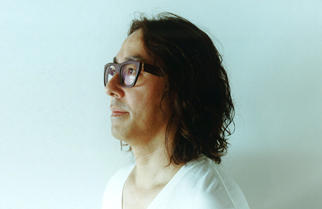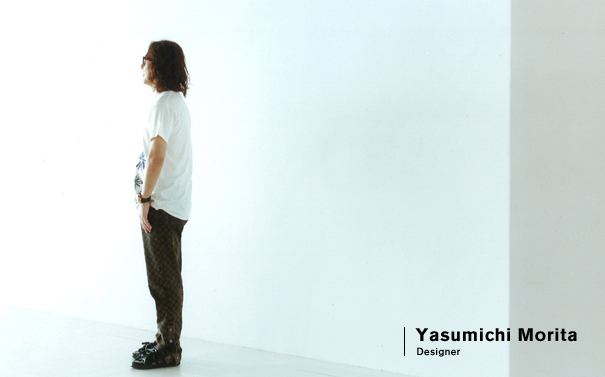
08 Yasumichi Morita (Desiger)
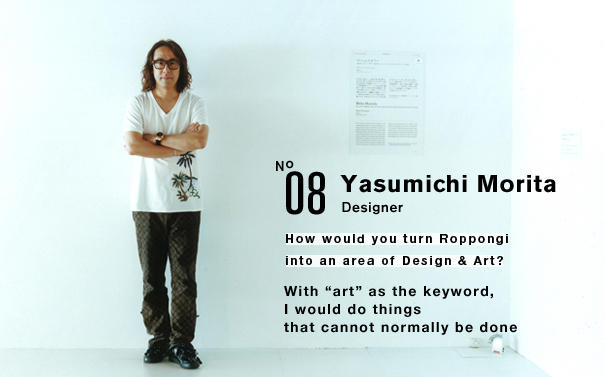
- JP / EN
Yasumichi Morita has designed attractive stores all over the world that have the power to draw people back again and again; he is currently undertaking eight projects worldwide. Morita knows countless places in Roppongi since he continues to come here for both work and leisure. The "Sky Dream Deck" event now taking place on the roof of Roppongi Hills Mori Tower is one of Morita's latest works. For this interview, Morita took time out from his busy schedule and came to the Mori Art Museum - on the 53th floor of the same Mori Tower building where the "Sky Dream Deck" is being held. It was evident from the way Morita walked about the building that he often comes here. Looking relaxed throughout the interview, Morita talked on many subjects including how his ideas are born.
"Desginer Morita" and "Artist Morita"
There are two people inside me: "Designer Morita", and "Artist Morita". When there is a need to promote a shop or a product within a rigid budget in order to boost business, then "Designer Morita" gets to work. "Artist Morita" does things quite freely - he does what he wants to do. I think the "Sky Dream Deck" was undertaken mostly by "Artist Morita". This project started when I was talking with the people at Mori Building and we were wondering what kind of interesting project we could implement. I am currently the (art) director at Disney (Tokyo Disney Resort), and I thought that perhaps I could take advantage of my position and do something that would not normally be possible.
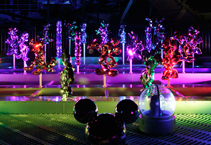
Sky Dream Deck
A music and light installation event is being held on the roof of Mori Tower to mark the 110th anniversary of Walt Disney's birth. Around 120 sparkling figures of main Disney characters are lighting up Roppongi, rotating like mirror balls to the sound of music.
Sky Deck, Rooftop of Roppongi Hills Mori Tower 6-10-1 Roppongi, Minato-ku, Tokyo
*Exclusive goods of the event are available at "Sky Dream Shop" inside the observation deck, Tokyo City View, on the 52th Floor
I wanted to plan a happy event which could only take place in Roppongi. And I got the idea of creating a glittering installation of music and light, featuring Mickey and all the well-known characters, which adults would be able to enjoy. I thought, "This is Roppongi. Let's make a disco. Let's make a mirror ball." And so we ended up making sculpted objects that go round and round while emanating light.
The power of art to connect people
We were able to hold this event, and the reason it was possible is that "art" is the keyword. Mickey is Mickey Mouse as we all know him, but he was also depicted as an object of art, and when seen in that light, people who look at the character can discover new things and be inspired. Because this was art, the people at Disney and Mori Building agreed to the project, and I was able to create the world I had in mind. Things that are normally not possible become possible when "art" is the keyword because it connects people, and leads to spicy, stimulating creations. I think that's a wonderful thing.
When pondering art, the thing I keep in mind is to make creations that do not require a lot of explanation. Some people make works that can only be understood after you have read the whole explanation, and sometimes there are works that cannot be understood even after that; I suppose they can be interesting in their own way, but in my case, I place importance on making things that can be enjoyed by everyone - from children to grandfathers and grandmothers - regardless of age, gender and nationality.
Powerful works that need no explanation
A work is more likely to leave an impression, and be understood by people if it does not require explaining. The few words that a person uses to describe something are very important. If someone who saw something said, "It sparkled and was fun.", then those words would have much more power compared to "Umm. It's difficult to explain."
And when people tell other people about something, the message is passed on to wider circles, and more people will come to an event, and keep coming back.

Mori Art Museum
An art museum on the 53rd floor of Roppongi Hills Mori Tower. Innovative exhibitions of many other genres including photographs, design, fashion and architecture are held here. The museum is open until 10 p.m., and people can casually enjoy art on weekdays after work.
Roppongi Hills Mori Tower 53F, 6-10-1Roppongi, Minato-ku, Tokyo
The location of Roppongi is very accessible for all kinds of people, so in the future I would like to make take up more challenges like the recent project. If I were told that I could do another project I liked in Roppongi as "Artist Morita", I think I would create a disco (laughs). Since the rooftop disco became a reality in Roppongi Hills, my next dream would be to design an indoor disco in Tokyo Midtown.

Designing the way we shop - designing our experiences
This is not about Roppongi, but I would like to mention one of the projects I'm currently involved in which is the renewal of Isetan Shinjuku's main store. The grand opening will be in March 2013. I feel that it's the element of entertainment that makes department stores appealing. When I was a child, I remember being able to play all day at the department store and I hope to recreate that sense of fun. There are a lot of ideas I have in mind; one is to create a "park" in the middle of each floor. The park will function like the hall of an art musuem; from those areas, people will proceed to look at the clothes and items as if they were works of art.
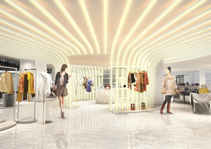
Redevelopment of Isetan Shinjuku main store
Morita is in charge of renovating the Basement 2nd and 1st floor, 2nd floor, 3rd floor and 4th floor of Isetan Shinjuku main store, a long-established department store in Shinjuku. Based on the concept of creating the world's best fashion museum, the store is aimed to become a naturally appealing place that people would want to visit even if they have no shopping plans. Its grand opening is scheduled in spring of 2013.
Shinjuku 3-14-1, Shinjuku-ku, Tokyo
At Isetan Shinjuku's main store, I'm trying to design the way we shop. It will be a totally different style of shopping from the way we shop now; the shop will be like the world's best fashion museum. This is not about making a gorgeous interior by using luxury materials. It's about looking at clothes as art, and doing your shopping while walking around exhibition rooms as in an art museum. I think designing that kind of new experience is what is necessary these days.
A third each of Tokyo, Hong Kong and Malibu
I guess the city I like best is Tokyo. After all, this is where I actually live. In the past, my favorite city was Paris; I also like Hong Kong where I have one of my work bases, and I'm also fond of Qatar and Los Angeles. Each place has its uniquely good qualities. Recently though, I've been talking a lot to the people at my office about how nice it would be if I could have a house - a small house would be fine - around Malibu in Los Angeles.
The good thing about Los Angeles is that while the town is not very big, you can enjoy both the interestingness of city life and the slow-paced atmosphere around Malibu; it's similar to my hometown of Kobe where both the town and the sea are near. So my ideal life would be spending a third of my time in Tokyo, a third in Hong Kong and a third in Malibu. Although my staff will probably want me to do my job and would tell me to return straight back to Tokyo. (laughs)
More Japanese should be giving out information abroad
Working at my bases both in Japan and abroad, I notice that the Japanese excel at receiving information but are not so good at sending out information. There are people who are very informed about things that take place abroad like boutiques opening in Paris, and they might even be more knowlegeable than the Parisians. Yet despite being so informed, they don't venture to go out into the world - they are not very interested in working abroad. There might be the problem of language, but I get the impression that the Japanese are sort of isolated. I wish that more Japanese will actively go abroad and give out information not only on the Japanese culture but on a lot of other things.
Right now, I'm pushing forward with a simultaneous project in eight countries, but what people are looking for are the same in every country. People want things that have originality and power and which can be enjoyed by the local residents. It's the same when designing shops for Roppongi. In Roppongi though, there are many highly-sensitive people, and people from all over the world come here, so I feel a special pressure to be original and to express a Roppongi-like allure.

My current work is based on the things I learnt partying here
In my youth, Roppongi was the place of inspiration for me. There was the Vietnam restaurant "AD Colosseum", and the restaurant bar "Tonfu" that was located on the Imo-araizaka slope; there were so many fascinating places that had been created by the "senpais". There was a time when I would come here from Kansai on the late-night bus, spend hours having a good time, and then get on the late-night bus again to go home. Roppongi seemed to me to be a town that drew interesting people from all over the world; my imagination was stimulated and I learnt a lot while partying. The shops and art works I am creating now are all based on that experience.
Akasaka AD Colosseum
Japan's first French Vietnamese restaurant designed by venue designer Atsushi Sato. The restaurant was located inside Ark Hills in the 1980s and was a popular spot for disco-goers who came here after dancing to enjoy wine and Vietnamese meals.
So I was really pleased when I was able to do interior work for shops in Roppongi. The very first shop I designed was "Vitamine Tokyo French" which used to be in an area behind "WAVE". I've designed countless shops since then including "Restaurant Mado Lounge" at Tokyo City View and "Roppongi Shokudo" in Roppongi Hills, "orangé" and "RISONA bank" in Tokyo Midtown, the bar "Roku Nana" in Roppongi Nanachome and the bar "D" and "FeriaBldg." opening in this August. When I think about it, I realize that ever since I started working, I have always had some connection with Roppongi. Perhaps it's not what can be called "art", but I do have this wish to create places where all kinds of discoveries are made - where all kinds of people meet and have chemical reactions.
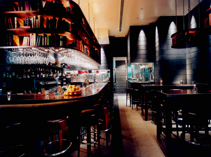
orangé
A French bistro where the fresh scent of orange fills the air. Mimosa is served in the lunchtime, orange juice is served for afternoon tea, and the scent of orange pervades the night as well. A casually elegant place to enjoy meals and drinks.
East 1F, Tokyo Midtown, 9-7-1 Akasaka, Minato-ku, Tokyo
Looking for treasures in the morning, daytime, evening and midnight.
There's a distinctive relaxed atmosphere in Roppongi that cannot be found in either Shibuya or Nihonbashi. And in that easy-going atmsophere, there is a lot of spicy stimulation. Roppongi is not a very big area, but all types of people from around the world come here. In the past, it was a lively area only at night, but now people gather here during the day as well.
I think people come here because of expecations that they might find something interesting. It's a bit like treasure-hunting. People are looking to make encounters with people, to discover attractive things; Roppongi is about the only place where there are so many art galleries and art museums in the same vicinity, and I think people come here hoping to find something. With the redevelopment, offices have increased and there are more places now where you can buy fresh groceries - like the supermarkets in Tokyo Midtown. And there are so many places to go to for lunch. Morning, noon, evening, midnight.. there is always movement in Roppongi.
In this way, to me, Roppongi is an area where I can drink champagne in the morning, noon, evening and midnight. (laughs) For instance, in the daytime, I might have a lunch meeting at the "The Oak Door Steakhouse" in the Grand Hyatt Tokyo and have champagne. We will have another meeting in the afternoon, and it will be like, shall we have something to drink? and so we will have afternoon champagne. Then it will be dinner time and so we will drink champagne again. Then it will be like, shall we drink some more? and we will have our evening champagne. Then we will be drinking champagne in the early hours of the morning and then go to sleep. (laughs)
The way ideas come to me
It might sound as if I am fooling about every day, but I do my work seriously, you know. When I am thinking of plans, I don't use pens. I hold a pen when we come to the stage of design and we need to decide on the details and the measurements, but I find that when I hold a pen in my hand at the stage of planning, I tend to be caught up with form. I find myself trying to come up with beautiful forms or cool forms. What's more important than form though, is the ideas that come to me in everyday life. For example, I might be drinking at some place and see a pretty woman walk by and think, "I'd like to design a shop that would draw customers like that person." Or I might watch children with their parents and think about creating places that would be welcoming for both adults and their children. It's important to think about what kind of people you want to come to the place you are about to make. So I think hard about the basic things and do all the editing in my head. Shops need art and a story - without them, they can't get started.
There are still many places in Roppongi that have not been developed, and I think there's still a great deal of potential in digging deeper and making this area even more interesting. A new bar called "R2 Supper Club" opened recently in Roppongi; it's filled with so many people from the early evening that you have to wade through the crowd to get in. There are few Japanese there, and most are foreigners who are neatly dressed. It's a loose community now, but I think if you take a close look at each of the the different people from all over the world who come here, and observe their various traits, more interesting gatherings could be held here that would be possible only in Roppongi and nowhere else.
I hope that many more business people will come to Roppongi and seize opportunities for themselves. As for myself, I hope to continue making places in Roppongi where people make encounters and where lots of new chemical reactions occur.
Editor's thoughts
When Morita-san said that Roppongi is an area where you can have "shan" in the morning, noon, evening and midnight, I took "shan" to mean "shampoo" and thought, that's why his hair looks clean. Later I realized he was talking about champagne! Morita-san smiled often as he talked, and a relaxed atmosphere prevailed throughout the interview. (edit_rhino)




